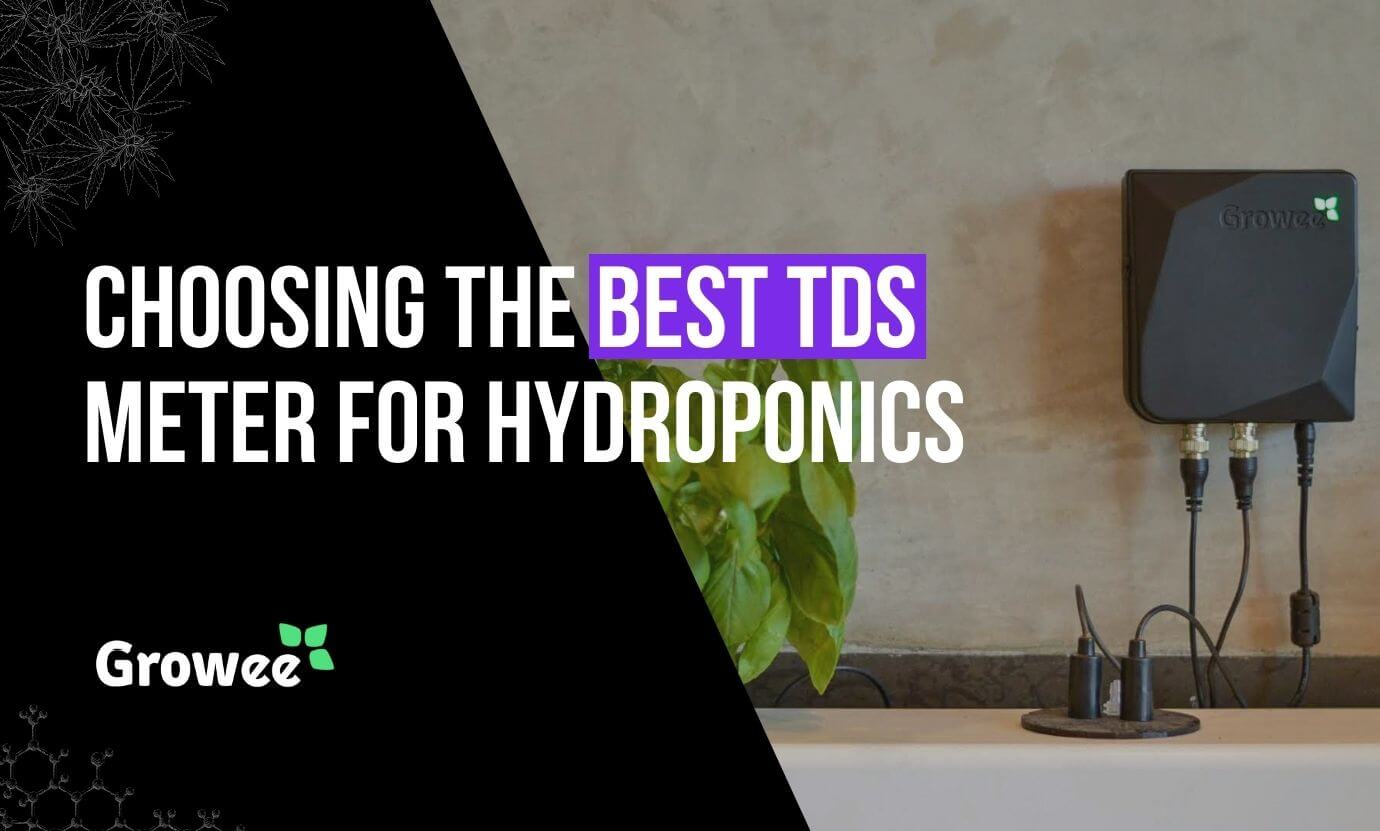When growing hydroponically, there are various tools that you’ll need for success. Being able to accurately measure nutrient levels in your nutrient solution can make the difference between a successful and a failed crop. To this end, something you’ll want to invest in is a TDS meter.
A TDS meter will help you determine what the concentration of nutrients in your solution is, thus allowing you to make adjustments as needed. That said, there are plenty of different TDS meters out there, and they’re not all built the same. We’re here to help you make a choice.
What is TDS?
TDS in hydroponics stands for “total dissolved solids”. This is a measurement of how much minerals and salt are in your watering solution. This is measured in PPM or parts per million. If you have soft water, it means that it contains a low amount of total dissolved solids, whereas hard water is characterized by a high amount of total dissolved solids.
If you get a low PPM reading, you’ll need to add more nutrients into your reservoir, and if you get a high reading, you’ll need to replace some of the nutrient solutions with plain water or RO water. Depending on the stage of growth, PPM readings may need to be anywhere between 100 and 1600, something we’ll explain further below.
See How Growee Can Save You Time By Automating Your Plants Feeding
Water pH – Automated pH Up and Down Control
Nutrients Mixing – Automated Nutrient Dosing with Target EC / PPM Control.
Control From Anywhere – WiFi Connection and mobile App
What is EC?

EC stands for “electrical conductivity”, and as the name suggests, is an indication of the level of electrical conductivity within a nutrient solution. The reason why this is a relevant measure in hydroponics is because the minerals and salts contained in the solution are usually conductors of electricity.
Therefore, by measuring the EC of a nutrient solution, you can determine what the current nutrient level is. EC is measured in millisiemens per centimeter or (mS/cm). Generally speaking, flowering and fruiting plants enjoy higher EC levels ranging anywhere from 2.0 to 5.0 mS/cm.
Ideal Nutrient PPM for Cannabis Plants According to the Growth Stage

Just so you know what the PPM for your cannabis plants should be according to the growth stage, refer to the below information. As you’ll see, the further your plant gets in its growth cycle, the more nutrients it will need.
- Seedlings: 100 to 250 PPM
- Early Veg: 300 to 400 PPM
- Late Veg: 450 to 700 PPM
- Early Flowering: 750 to 950 PPM
- Late Flowering: 1,000 to 1,600 PPM
- Pre-Harvest: As Low as Possible
Why Are Growers Using TDS Meters in Hydroponics?
The reason why growers are using TDS meters in hydroponics is very simple, because they provide accurate readings of the level of dissolved nutrients in the water. This is very important for growing plants of all sorts, whether cannabis or otherwise.
As you can see from above, plants require different amounts of nutrients or TDS depending on the state of growth. If plants don’t get enough nutrients, they will suffer from nutrient deficiencies and stunted growth. If plants are receiving too many nutrients, they can suffer from nutrient burn, and ultimately die.
Therefore, having a way to accurately measure the TDS or amount of nutrients in the water is vital. Hydroponics requires growers to constantly maintain ideal TDS levels for optimal plant growth, or else risk poor growth, low plant quality, or even the outright death of the plants.
Understanding EC vs TDS/PPM
What can get very confusing for beginner growers is the difference between EC and TDS. Now, what needs to be said is that both are measurements of the amount of nutrients in the water. However, one defining factor is that TDS values can be used as is and are direct. They are easy to understand.
On the other hand, EC values are much harder to understand, which means that growers often convert EC readings to TDS values, which requires a complex formula. The issue with many standard EC meters however is that they may have different standards or conversion factors.
There are three conversion factors commonly used, including 0.5, 0.64, and 0.7. This means that the same EC measurement, depending on the conversion factor used, can result in vastly different TDS figures. If a factor of 0.5 is used to convert EC to TDS, the result will be very different than if a factor of 0.7 is used.
The primary difference is that EC readings are standardized and very reliable. They are a direct measure of the conductivity of water. EC readings also aren’t susceptible to differing conversion factors, another benefit that adds to their reliability.
However, EC readings are also very hard to understand, which is exactly why so many convert them into TDS levels. TDS is much easier to understand, especially for beginners, as it provides you with a simple-to-read numerical value, such as 300 PPM. It’s intuitive and easy to understand.
Due to difficulty with conversion, and EC being difficult for beginners to understand, many who need to monitor nutrient levels in their hydroponic systems opt for high-quality TDS meters. They’re just much easier to use!
How to Choose the Best TDS Meter for Your Hydroponics System
Choosing the right TDS meter for your needs depends mainly on the size of the operation you have, as well as your budget. If you are a beginner operating on a limited budget, you’ll probably go for something lower-end and more economical. There are plenty of entry-level TDS meters out there, and just because they don’t cost much, doesn’t mean that they aren’t reliable.
However, the issue with lower-end TDS meters is that they just don’t come with the same level of functionality and breadth of features as the higher-end models, such as the Hydro Master, that provides highly accurate PPM readings on a constant basis.
One of the big benefits of purchasing a higher-end model is that it may come with functions such as internet connectivity, which makes life a lot easier.
Instead of having to take manual TDS readings directly from the source, you can just leave the internet-capable TDS meter in your hydroponic reservoir, and then use the corresponding app on your mobile device to receive real-time updates in terms of EC and PPM readings.
Modern TDS meters often allow for nutrient dosage systems to be connected to them. It makes growing much easier, because the TDS meter can take real-time readings and send a signal to the nutrient dosing system to adjust nutrient levels as needed.
Although lower-end models may not be inherently inaccurate, the old saying, you get what you pay for, does hold true to a certain extent.
The simple reality is that more expensive and higher-end units tend to be much more accurate and reliable, with a much smaller margin for error. When it comes to getting the most out of your crop, accuracy as far as nutrient levels are concerned is crucial.
How Growee is Taking TDS/EC Monitoring to the Next Level
Growee is taking TDS and EC monitoring to the next level thanks to the Growee Hydro Master, combined with the Growee App. The Hydro Master is a state-of-the-art smart controller for hydroponics systems.
It is able to accurately track TDS, EC, pH, and water temperature, all in real-time. This means that you can connect the Hydro Master to the Growee App on your mobile device, and receive constant and accurate real-time updates about all of these important metrics no matter where you go.
Even better is the fact that you can add additional hardware to the Hydro Master, such as the Growee dosing units that automatically adjust both the pH and TDS levels of your nutrient solution based on the real-time readings from the Hydro Master.
TDS Meter vs Growee Wifi TDS Monitoring
A regular TDS meter is fine if you want to sit beside it all day long for readings. However, if you are busy and can’t be home all day, then Growee Wifi TDS monitoring is the way to go.
The fact is that with a Wifi-enabled monitor, such as the Hydro Master, you can get real-time readings wherever you go, and thanks to the Growee dosing systems, you don’t have to run home every time TDS levels are off. The system will take care of it all on its own.
Choosing the Right TDS Meter – Final Thoughts
If you need a good TDS meter that provides you with real-time readings on your mobile device, then there’s simply nothing better than the Growee Hydro Master, the best hydroponics system!

FAQ
What Meters do I Need for Hydroponics?
For hydroponics, a TDS, pH, and temperature meter are required.
What is the Difference Between a TDS, PPM, and EC Meter?
EC measures the electrical conductivity of a nutrient solution, whereas a TDS meter measures the total dissolved solids, displayed as PPM.
How Accurate are TDS Meters?
Most TDS meters are accurate to within 20 PPM.
How do I Choose a TDS Meter?
Choose a TDS meter based on its accuracy, durability, and overall functionality. We recommend a model that is Wifi capable, as this allows for much easier and efficient readings and dosing.



